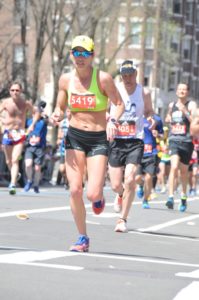
Boston Marathon, 2015.
Boston Marathon. For many runners, it is essentially the magic unicorn of marathon running. For many runners, qualifying is a goal. It takes some of us numerous attempts, years of hard work, and some soul-crushing attempts. But there is nothing like Boston. Once you’ve stamped that qualifier, you are in for one epic ride. There are few things that compare to the feeling of being in your corral in Hopkinton. Being around thousands of other runners who all met a time standard, whether on first attempt or 10th – the energy at the starting line is something unique.
As I sit on my Amtrak ride up to Boston for my 5th attempt from Hopkinton to Boylston Street, preparing for what will be perhaps the worst weather I have yet to trek 26.2 miles through, I am filled with peace. No nerves. No negativity about the weather. If I’d planned to really race my best tomorrow, I’d be a stressed out mess. But each marathon has taught me something new about myself and the sport. With this being my 18th (or 19th?) marathon, I have learned to accept the things I cannot control and to instead focus on the things I can. Bad weather is part of marathons. It’s a big part of Boston Marathon. These less-than-ideal days make the good days that much more rewarding when they happen.
I’ve probably stalked the forecast a good 100 times in the last week. No joke. But I keep reminding myself that no matter how much rain or headwind we have tomorrow, it’s better (and probably safer) than a hot and sunny Patriots Day. No matter the weather, this is Boston Marathon. I’ll be out there in good company with other strong and accomplished marathoners. The best marathoners in the world will be leading the way. The crowds will still be strong, cheering on and celebrating, because it’s Boston.
If you are running tomorrow and freaking out (a natural reaction – especially if it’s your first Boston!) here are a few tips:
- Don’t fight the wind. Don’t fight the wind. DON’T FIGHT THE WIND. Instead, LISTEN to your body and exertion, and draft behind a group of taller runners whenever possible.
- Don’t go out too hard. Boston is a pretty fast course. The biggest challenge is the Newton Hills (mile 17-21.) Don’t be scared of the Newton Hills. There are downs to counter the ups. But they are at a tough place in the marathon. The first half of the course is pretty fast, and it’s tempting to go out hard and “bank” time. Try to resist that urge. You risk hitting those hills with quads that are tanked from the downhills.
- Do stay warm and dry pre-race. Use the tents in Athlete’s Village. Bring layers. Bring plastic bags. You lose energy shivering and try to stay warm. You want your energy for your 26.2 mile journey.
- Do still hydrate early and often on the race course. Despite cool and wet conditions, you’ll still be sweating and burning up your glycogen storage.
- Do take in the energy from the spectators. Give high fives, cheer, hoot and holler! It’s BOSTON MARATHON!!!! Make the most of this experience. You’ll make memories no matter what. Choose to make them good ones.
- If Boston IS your goal race, don’t lose hope that the PR is out of the cards. Yes, the odds are sadly not great. But you know your training. You know what you’ve trained through. You know your strengths and weaknesses. Just go to the starting line at peace with a few backup goals, just in case the wind is too much.
For many of us marathoners, this unicorn is the height of our marathon racing in a few ways. Aside from a few marathons that offer some perks for speedy qualifying standards, most of us are never going to make it to Olympic Trials. Boston is the “reach” goal. It’s special. It’s a race that should be saved for that BQ (my opinion) and then means so damn much once it’s achieved. No matter the weather, tomorrow will be a day. An opportunity. So we’ll get a little wet and run into some gnarly wind for a couple of hours. I can find few better ways to spend a Monday.
 It’s the time of year where many runners who hibernate during the dark and cold Winter months take their first few miles of the year. It’s also the time of the year for Newbies! Perhaps inspiration from a friend or family member, a stress in life is forcing a change, something has sparked the interest in the sport – new runners are testing out their running legs. If you’re new and flirting with the idea of running, or you’re coming back from a serious hiatus, here are some tips and tricks for getting started.
It’s the time of year where many runners who hibernate during the dark and cold Winter months take their first few miles of the year. It’s also the time of the year for Newbies! Perhaps inspiration from a friend or family member, a stress in life is forcing a change, something has sparked the interest in the sport – new runners are testing out their running legs. If you’re new and flirting with the idea of running, or you’re coming back from a serious hiatus, here are some tips and tricks for getting started.
 This past weekend I stepped up to the starting line of my first of two big goals for 2018. After an amazing experience at
This past weekend I stepped up to the starting line of my first of two big goals for 2018. After an amazing experience at  The new year is on the horizon, and you have decided you are going to take up running! Great! Here are some tips to help you ease into a new sport carefully, so that you reduce injury risk, build as a runner, and have fun. Be patient and remember to accept that you can’t be an expert in anything overnight. Enjoy the journey and learn from your experience.
The new year is on the horizon, and you have decided you are going to take up running! Great! Here are some tips to help you ease into a new sport carefully, so that you reduce injury risk, build as a runner, and have fun. Be patient and remember to accept that you can’t be an expert in anything overnight. Enjoy the journey and learn from your experience.


